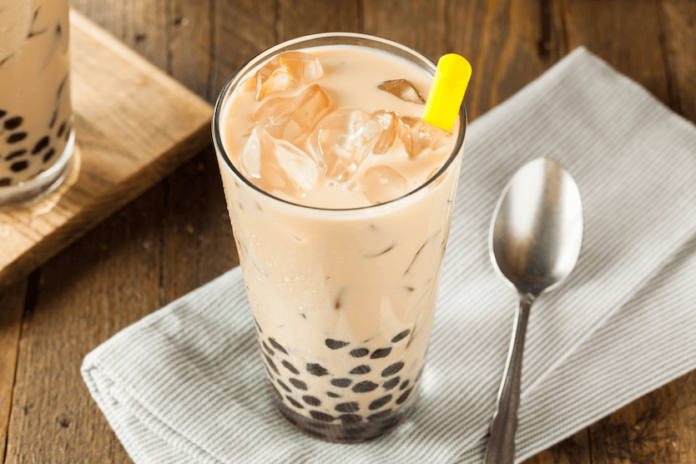Taro milk tea is a unique and delicious drink that has been gaining popularity around the world, especially in Asian countries. But what exactly is taro? What does taro milk tea taste like? And are there any health benefits to this indulgent beverage? In this article, we will explore the answers to these questions and more.
What is Taro?
Taro is a starchy root vegetable that is native to Southeast Asia but is now grown in many parts of the world. It is a popular ingredient in many Asian dishes, from savory stews to sweet desserts. Taro has a distinct purple color and a slightly sweet, nutty flavor that is reminiscent of chestnuts or sweet potatoes. The root is often boiled, steamed, or mashed before being added to dishes.
What Does Taro Milk Tea Taste Like?
Taro milk tea is a creamy and indulgent drink that has a slightly sweet and nutty flavor, thanks to the taro root. The drink is made by blending together taro root, milk, and sweetener, such as honey or sugar. The result is a light purple drink that is both refreshing and satisfying. The taste of taro milk tea can be compared to a cross between a latte and a sweet potato pie.
What are the Health Benefits of Taro Milk Tea?
Taro milk tea is not only delicious but also has several potential health benefits. Here are some of the benefits of this popular drink:
- Rich in Nutrients: Taro root is a good source of nutrients such as fiber, potassium, vitamin C, and vitamin E. These nutrients are essential for maintaining a healthy immune system, reducing inflammation, and improving digestive health.
- Boosts Energy: Taro root is a good source of complex carbohydrates, which are slowly absorbed by the body, providing a steady stream of energy. This makes taro milk tea a great drink to have before a workout or as a midday pick-me-up.
- Promotes Healthy Skin: Taro root is rich in antioxidants, which help to protect the skin from damage caused by free radicals. This can help to reduce the signs of aging and keep the skin looking youthful and healthy.
- May Help to Regulate Blood Sugar: Taro root has a low glycemic index, which means it is absorbed slowly by the body, causing a gradual increase in blood sugar levels. This can help to prevent spikes and crashes in blood sugar levels, which can lead to cravings and overeating.
How to Make Taro Milk Tea at Home?
Making taro milk tea at home is easy and requires just a few simple ingredients. Here’s how to make it:
Ingredients:
- 1/2 cup cooked taro root, mashed or diced
- 1/2 cup milk (or non-dairy milk)
- 1-2 tablespoons honey or sugar, to taste
- Ice cubes
Instructions:
- Combine the mashed or diced taro root, milk, and sweetener in a blender.
- Blend until smooth and creamy.
- Pour the mixture over ice and enjoy!
Taro Milk Tea Variations:
There are many variations to this classic recipe, allowing you to customize your taro milk tea to your liking.
- Tea base: While traditional taro milk tea recipes do not include tea, many modern recipes add black tea or green tea to give the drink an extra boost of flavor and caffeine. You can experiment with different tea varieties to find your favorite.
- Milk: While dairy milk is the most common type of milk used in taro milk tea, you can substitute it with almond milk, coconut milk, soy milk, or any other non-dairy milk for a vegan or lactose-free version.
- Sweetener: Taro milk tea is typically sweetened with sugar or honey, but you can use other sweeteners like agave syrup, stevia, or monk fruit sweetener for a healthier option.
- Toppings: Taro milk tea can be topped with a variety of toppings, such as grass jelly, aloe vera, or pudding. You can also add a dollop of whipped cream or sprinkle some crushed Oreos for added indulgence.
- Ice: Taro milk tea can be served hot or cold, depending on your preference. If you like it cold, you can add ice cubes or use blended ice for a slushie-like texture.
For an extra indulgent treat, you can also add Bobba or bubbles made from tapioca starch to your taro milk tea.
What is Taro with Bobba?
Taro milk tea with bobba is a popular variation of the classic drink. Bobba, also known as bubbles or pearls, are small balls made from tapioca starch that are added to the drink. They have a slightly chewy texture that adds a fun and unique element to the drink. Taro milk tea with bobba has become a favorite among bubble tea fans and is now available at many bubble tea shops around the world.
Is Taro with Bobba healthy?
While taro milk tea with bobba is delicious, some people may wonder if it is healthy. Like most sweet beverages, taro milk tea with bobba is high in sugar and calories. A typical 16-ounce serving of taro milk tea with bobba can contain up to 350 calories and 50 grams of sugar. However, there are ways to make the drink healthier. You can reduce the amount of sugar in the drink or choose a sugar-free option. You can also use low-fat or non-dairy milk to reduce the calorie content.
Wrapping Up
Taro milk tea is a delicious and unique beverage that has gained popularity around the world. It has a nutty, slightly sweet taste and is made from the starchy root vegetable, taro. Taro milk tea is not only tasty but also has many health benefits, including improved digestion, healthy skin, and reduced inflammation. If you want to make taro milk tea at home, you will need taro root, milk, and sugar.
You can also add bobba to the drink for an extra chewy texture. While taro milk tea with bobba is high in sugar and calories, there are ways to make it healthier by reducing the sugar content or using low-fat or non-dairy milk.
Frequently Asked Questions (FAQs):
- Is taro root the same as ube?
No, taro root and ube are two different plants. Taro root, also known as Colocasia esculenta, is a starchy root vegetable that is commonly used in Asian and African cuisine. On the other hand, ube, also known as purple yam or Dioscorea alata, is a sweet potato-like root vegetable that is commonly used in Filipino desserts. - Does taro milk tea contain caffeine?Taro milk tea can contain caffeine, but it depends on the recipe and the type of tea used. Traditional taro milk tea recipes do not contain caffeine, but many modern recipes use black tea or green tea as a base, which can add caffeine to the drink.
- Is taro milk tea healthy?
Taro root itself is a good source of fiber, potassium, and vitamins C and E. However, most taro milk tea recipes contain added sugar and high-fat dairy products, which can contribute to weight gain and other health problems if consumed in excess. - Can taro root be eaten raw?
No, raw taro root contains calcium oxalate crystals, which can cause irritation to the skin and mouth, and can be toxic if ingested in large amounts. - Is taro root gluten-free?
Yes, taro root is naturally gluten-free, making it a good choice for people with gluten sensitivities or celiac disease.

















